4.3 Species at Risk
The federal Species at Risk Act (SARA) was passed in 2002 with the goal of preventing species from becoming extinct and implementing the measures needed for their recovery. It gives legal protection to wildlife and the habitat they need to survive.
Species at Risk listings are based on scientific assessments conducted by government agencies, conservation organizations, and experts in various fields. These categories help prioritize conservation actions and allocate resources effectively to protect and recover species at risk in Canada.
SARA classifies species into different levels based on their risk of extinction (Government of Canada, 2013):
- Extinct: A species that no longer exists anywhere in the world.
- Extirpated: A species that no longer exists in the wild in Canada but still exists elsewhere in the world.
- Endangered (EN): A species facing imminent extirpation or extinction in Canada if nothing is done to reverse the factors leading to its decline. They are legally protected under the federal Species at Risk Act.
- Threatened (TH): Species are likely to become endangered if the factors causing decline continue. They are also protected under SARA.
- Special Concern (SC): Species that may become threatened or endangered because of biological characteristics or identified threats.
The Committee on the Status of Endangered Wildlife in Canada (COSEWIC) evaluates the status of wildlife species and provides updated recommendations for listing. There are currently over 800 Species at Risk in Canada, including over 360 listed as endangered (Shape of Nature, n.d.).
Species at Risk in Ontario (SARO) also classifies species into different levels based on their populations within Ontario (Endangered Species Act, 2007). Many species at risk are listed under both SARA and SARO, but some species can be listed under one act but not the other. There are over 200 species at risk in Ontario (Kolarich, 2024) and over 50 located in London (Upper Thames River Conservation Authority, 2021).
Here are some examples of species at risk in London:
Monarch (Danaus plexippus)
Federal – Endangered, Provincial – Special Concern
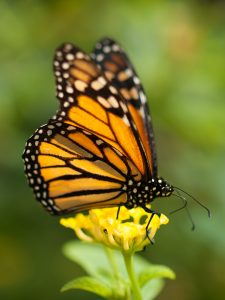
Description
The Monarch is a showy orange and black butterfly with small white spots. These butterflies are relatively large, with a wingspan reaching 9-10 centimetres. The caterpillars have black, white and yellow stripes and can be found feeding on milkweed. The Monarch is one of a few butterflies that migrate. Monarchs spend the winter in Oyamel Fir forests found in central Mexico (Government of Canada, 2023d; Government of Ontario, 2014d).
Threats
The largest threat to Ontario Monarchs is habitat loss and fragmentation at overwintering sites in Mexico. Forests are being logged and converted into agricultural fields and pastures (Government of Canada, 2023d; Government of Ontario, 2014d).
Spiny Softshell (Apalone spinifera)
Federal – Endangered, Provincial – Endangered
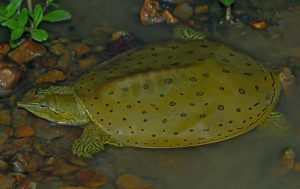
Description
The spiny softshell is a freshwater turtle with a round, rather flat, leathery shell. Unlike any other Ontario turtles, this species has a soft shell. The shell can grow up to 54cm long and is olive or tan in colour with dark blotches. The head is relatively narrow with a snorkel-like snout (Government of Canada, 2023e; Government of Ontario, 2014e).
Threats
The most significant threat to spiny softshell turtles is habitat degradation. Turtle habitat is being destroyed due to riverbank stabilization, development along shorelines, and recreation. Nest mortality can be very high due to human recreational activities at nest sites and nest predation by raccoons and foxes (Government of Canada, 2023e; Government of Ontario, 2014e).
Barn Swallow (Hirundo rustica)
Federal – Threatened, Provincial – Special Concern
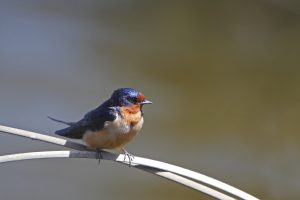
Description
Barn swallows are medium-sized songbirds (15-18 cm long). It has a glossy metallic blue back and upper wings and a rusty-red forehead and throat. It has long tail feathers, which form a distinctive, deep fork (Government of Canada, 2023a; Government of Ontario, 2014a).
Threats
The primary threat to barn swallows is a lack of food supply. Barn swallows feed on flying insects like flies, moths and bees. Habitat loss, pesticide use and climate change have caused significant declines in insect populations. The lack of insects for barn swallows leads to lower reproductive success and increased mortality (Government of Canada, 2023a; Government of Ontario, 2014a).
Butternut (Juglans cinerea)
Federal – Endangered, Provincial – Endangered
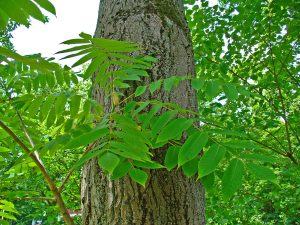
Description
Butternut is a medium to large, deciduous tree of the walnut family. It has compound leaves with 11 to 17 leaflets and hairy stalks. The Butternut fruit is a sticky-hairy, egg-shaped husk enclosing an edible nut that serves as a food source for small mammals like squirrels. Butternut is one of only two walnut species native to Canada, where it is at the northern limit of its native global distribution. Butternut trees can be found scattered across most mixed deciduous forests in Southern Ontario (Government of Canada, 2023b; Government of Ontario, 2014b).
Threats
The primary threat to butternut trees is butternut canker, a non-native fungal disease that spreads quickly and can kill a tree within a few years. Butternut canker was first confirmed in Ontario in 1991 and has had a devastating impact on butternut populations. There is no known treatment for infected trees (Government of Canada, 2023b; Government of Ontario, 2014b).
Eastern Hog-nosed Snake (Heterodon platirhinos)
Federal – Threatened, Provincial – Threatened
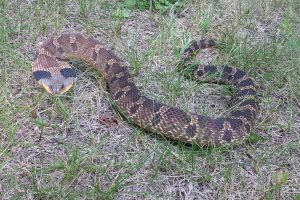
Description
The Eastern Hog-nosed Snake is a large, non-venomous, thick-bodied snake that can grow up to one metre long. It is easily identified by its distinctive upturned nose. When approached, this harmless snake coils up, flattens its head and neck to look like a cobra, hisses loudly and strikes with a closed mouth. If this frightening display doesn’t scare the predator or person away, the snake rolls onto its back with its mouth open and tongue sticking out in an extravagant death-feigning defence roll (Government of Canada, 2023c; Government of Ontario, 2014c).
Threats
Major threats to the Eastern Hog-nosed Snake include habitat loss from intensive agriculture and residential development, road mortality from an increase in road networks and harming or killing by people (Government of Canada, 2023c; Government of Ontario, 2014c).
A Closer Look
There are some species in London that are at risk of disturbance from humans, such as poaching (e.g. turtle nest sites), foraging (e.g. certain fungi or edible plants), intentional harm (e.g. snakes) and even photography (e.g. photographers overcrowding nesting sites of rare birds). In these instances, sharing location information can jeopardize the species at that site, particularly for stationary organisms, so it is best to “obscure” the location on iNaturalist. An “obscured” location only displays as a large rectangular box (around 20 km x 20 km), and the exact coordinates are not visible (iNaturalist, n.d.; shauns, 2024).
Users can specify how the location is displayed when recording an observation. The default is for observations to be “open”, meaning visible to the public, but you can hide the exact coordinates by adjusting the “Geoprivacy” to “Obscured” (iNaturalist, n.d.; shauns, 2024).
It is best practice to obscure location for species at risk observations. You may also wish to obscure the location for observations in your own home and backyard to keep the location of your residence private.

